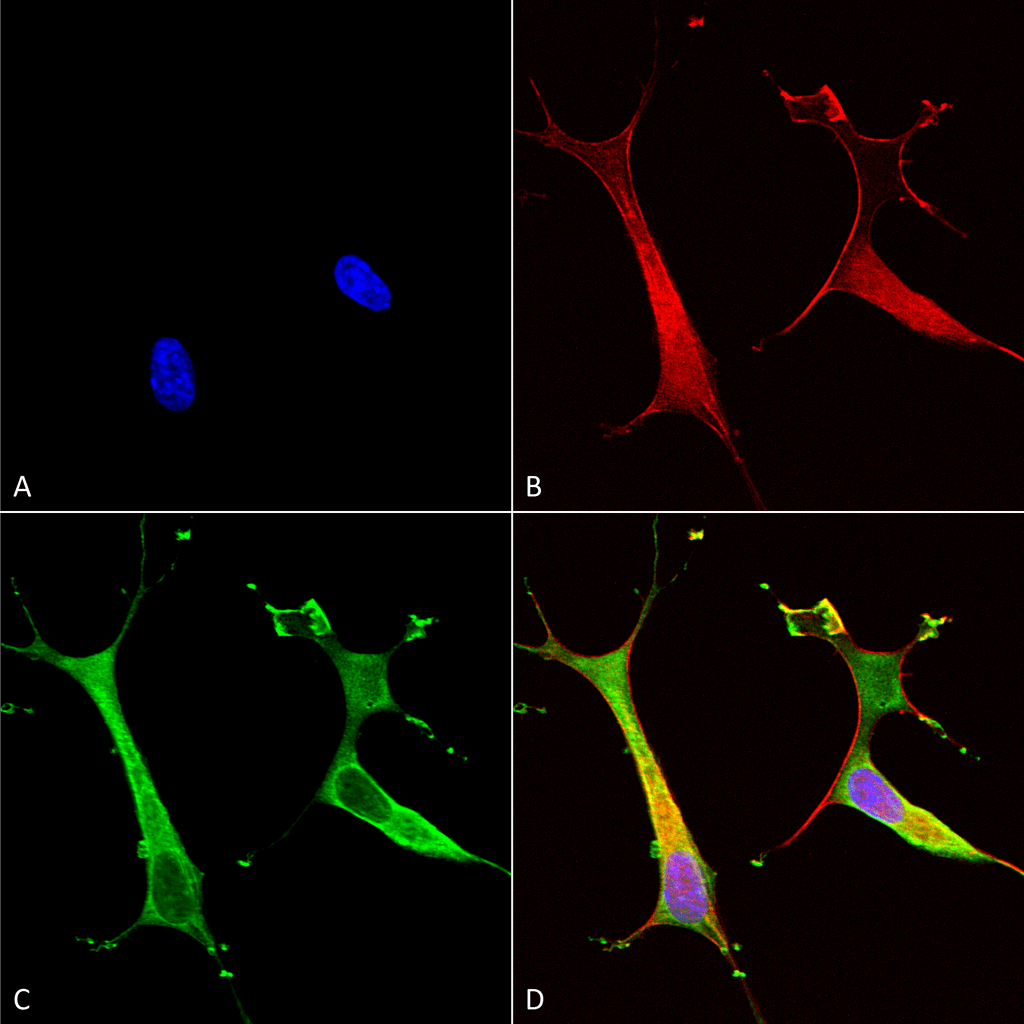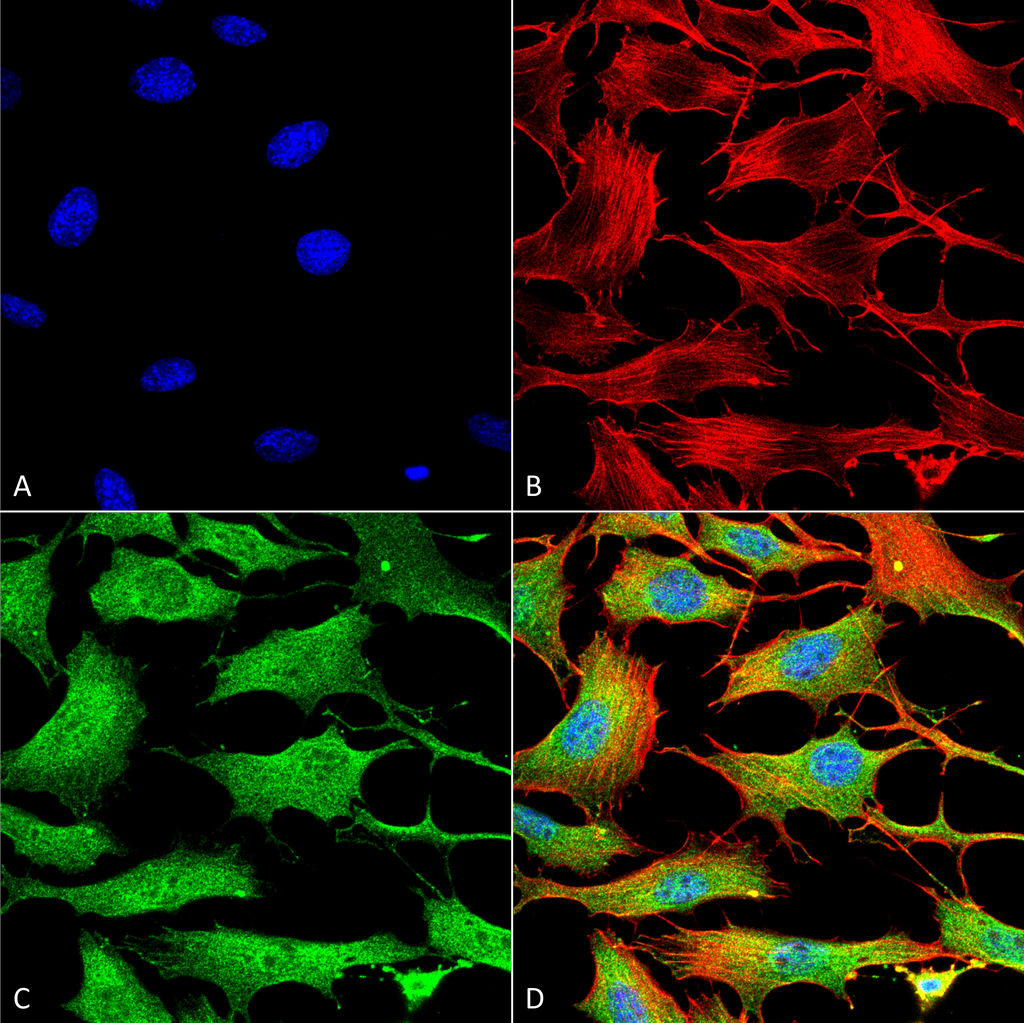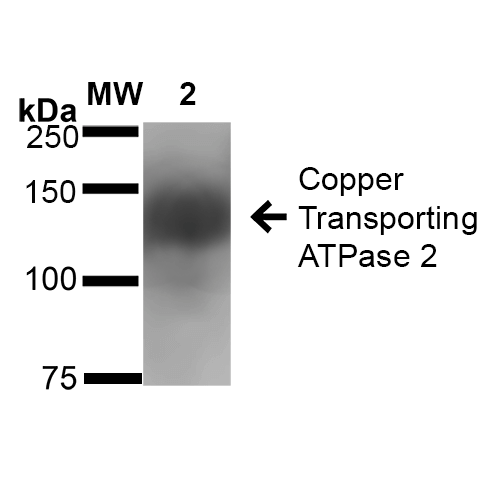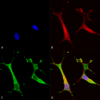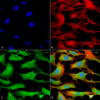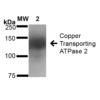Anti-Copper-Transporting ATPase2 Antibody (56517)
$466.00
| Host | Quantity | Applications | Species Reactivity | Data Sheet | |
|---|---|---|---|---|---|
| Mouse | 100ug | WB,IHC,ICC/IF,IP | Human, Mouse, Rat |  |
SKU: 56517
Categories: Antibody Products, Neuroscience and Signal Transduction Antibodies, Products
Overview
Product Name Anti-Copper-Transporting ATPase2 Antibody (56517)
Description Anti-Copper-Transporting ATPase2 Mouse Monoclonal Antibody
Target Copper-Transporting ATPase2
Species Reactivity Human, Mouse, Rat
Applications WB,IHC,ICC/IF,IP
Host Mouse
Clonality Monoclonal
Clone ID S62-29
Isotype IgG1
Immunogen Synthetic peptide correspond- ing to aa 3-21 (cytoplasmic N-terminus) of human Copper-Transporting ATPase2. (accession no. NP_000044.2).
Properties
Form Liquid
Concentration 1.0 mg/mL
Formulation PBS, pH 7.4, 50% glycerol, 0.09% sodium azide.Purified by Protein G affinity chromatography.
Buffer Formulation Phosphate Buffered Saline
Buffer pH pH 7.4
Buffer Anti-Microbial 0.09% Sodium Azide
Buffer Cryopreservative 50% Glycerol
Format Purified
Purification Purified by Protein G affinity chromatography
Specificity Information
Specificity This antibody recognizes human, mouse, and rat Copper-Transporting ATPase2.
Target Name P-type Cu(+) transporter
Target ID Copper-Transporting ATPase2
Uniprot ID B7ZLR4
Gene Name ATP7B
Research Areas Neuroscience
Background The copper efflux transporters ATP7A and ATP7B sequester intracellular copper into the vesicular secretory pathway for export from cells. ATP7b (also known as Copper-Transporting ATPase2) transports copper in and out of cells using ATP. There are 3 known isoforms of the ATP7b gene: A is found in the liver, kidney and brain, the shorter form B is found in brain, and the third isoform, known as WND/140KDA is found in mitochondria. Mutations in the ATP7b gene can cause Wilson's disease, an inherited disorder causing copper poisoning in the brain and liver.
Application Images




Description Immunocytochemistry/Immunofluorescence analysis using Mouse Anti-Copper Transporting ATPase 2 Monoclonal Antibody, Clone S62-29 (56517). Tissue: Neuroblastoma cells (SH-SY5Y). Species: Human. Fixation: 4% PFA for 15 min. Primary Antibody: Mouse Anti-Copper Transporting ATPase 2 Monoclonal Antibody (56517) at 1:100 for overnight at 4°C with slow rocking. Secondary Antibody: AlexaFluor 488 at 1:1000 for 1 hour at RT. Counterstain: Phalloidin-iFluor 647 (red) F-Actin stain; Hoechst (blue) nuclear stain at 1:800, 1.6mM for 20 min at RT. (A) Hoechst (blue) nuclear stain. (B) Phalloidin-iFluor 647 (red) F-Actin stain. (C) Copper Transporting ATPase 2 Antibody (D) Composite.

Description Immunocytochemistry/Immunofluorescence analysis using Mouse Anti-Copper Transporting ATPase 2 Monoclonal Antibody, Clone S62-29 (56517). Tissue: NIH 3T3 (NIH 3T3). Species: Mouse. Fixation: 4% Formaldehyde for 15 min at RT. Primary Antibody: Mouse Anti-Copper Transporting ATPase 2 Monoclonal Antibody (56517) at 1:100 for 60 min at RT. Secondary Antibody: Goat Anti-Mouse ATTO 488 at 1:200 for 60 min at RT. Counterstain: Phalloidin Texas Red F-Actin stain; DAPI (blue) nuclear stain at 1:1000, 1:5000 for 60 min at RT, 5 min at RT. Localization: Cytoplasm . Magnification: 60X. (A) DAPI (blue) nuclear stain. (B) Phalloidin Texas Red F-Actin stain. (C) Copper Transporting ATPase 2 Antibody. (D) Composite.

Description Western Blot analysis of Rat Brain Membrane showing detection of ~160 kDa Copper Transporting ATPase 2 protein using Mouse Anti-Copper Transporting ATPase 2 Monoclonal Antibody, Clone S62-29 (56517). Lane 1: Molecular Weight Ladder (MW). Lane 2: Rat Brain Membrane cell lysate. Load: 20 µg. Block: 2% BSA and 2% Skim Milk in 1X TBST. Primary Antibody: Mouse Anti-Copper Transporting ATPase 2 Monoclonal Antibody (56517) at 1:1000 for 16 hours at 4°C. Secondary Antibody: Goat Anti-Mouse IgG: HRP at 1:100 for 60 min at RT. Color Development: ECL solution for 6 min in RT. Predicted/Observed Size: ~160 kDa.
Handling
Storage This product is stable for at least 1 year at -20°C. Freeze in multiple aliquots to avoid repeated freeze-thaw cycles.
Dilution Instructions Dilute in PBS or medium that is identical to that used in the assay system.
Application Instructions Immunoblotting: use at 1-2ug/mL. A band of ~160kDa is detected.
Immunohistochemistry: use at 1-5ug/mL.
These are recommended concentrations.
Enduser should determine optimal concentrations for their applications.
Positive control: rat brain membranes.
Immunohistochemistry: use at 1-5ug/mL.
These are recommended concentrations.
Enduser should determine optimal concentrations for their applications.
Positive control: rat brain membranes.
References & Data Sheet
Data Sheet  Download PDF Data Sheet
Download PDF Data Sheet
 Download PDF Data Sheet
Download PDF Data Sheet

